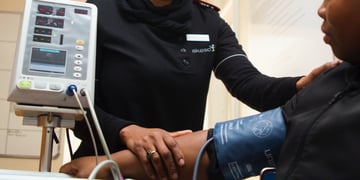NHS Staff Engagement Strategy: Beyond Patient Engagement
2 minute read | 06/05/2022

Patient engagement has been a priority in healthcare for years. We understand how patient engagement improves readmission rates, enhances patient education and accelerates patient satisfaction – but what about staff engagement? How important is staff happiness in creating a functioning hospital environment?
It turns out to be quite important.
Hospital staff also need to be engaged to consistently deliver a high quality of care and positively influence the patient experience. If staff feel overworked, indifferent or detached from their work, this sentiment spreads from practitioner to patient, causing problems from an increase in human error to a negative impact on patient morale. Therefore, an NHS staff engagement strategy is of the utmost importance.
Here’s how to prioritise both those who deliver and receive healthcare.
Assessing Staff and Patient Needs to Create a Staff Engagement Strategy
We’re already knowledgeable about patient needs with numerous studies on the subject and purpose-built platforms created to combat patient experience. But what do hospital staff require to keep them engaged in their role?
Surprisingly, hospital staff and patients have needs in the same areas; efficiency, engagement, entertainment and education. For example, while patients might require educational materials to help them understand their diagnosis, staff require test results, dosage information and other data to carry out their duties.
This begs the question — to create a staff engagement strategy, does there need to be a separate solution for staff and patients?
Making Staff Engagement Strategies More Efficient and Inclusive
Since the needs of staff and patients are so intertwined and the adoption of different technologies can be complex, it makes sense for both practitioner and patient to utilise the same platform to fulfil their requirements.
This can be easily done in areas such as entertainment, where the needs of staff and patients are relatively identical. With a patient experience platform, both staff and patients can access TV, film, radio and more on their personal devices.
Still, some areas of need differ, requiring a different level of access to the same software or a personalised portal. For example, patient engagement may include functions such as feedback surveys and educational materials. Educational materials and patient surveys aren’t relevant for staff, instead requiring a professional equivalent.
Catering for Staff and Patients to Deliver The Ultimate NHS Staff Engagement Strategy
It makes practical and financial sense to align both patient and staff engagement strategies, saving money and time for the NHS. However, planning and implementing an engagement strategy can be difficult to employ.
In his latest talk, WiFi SPARK CEO, Matt O’Donovan, discusses how we can utilise existing hospital technology to make a cost-effective and efficient hospital-wide strategy.
Listen to the entire talk, which details the three-year plan for a better patient experience, the acquisition of Hospedia and how it relates to this vision. If you want to understand how to navigate complex care delivery to a diverse group of patients using an inclusive infrastructure, fill out the form below.
About the author
Matt O'Donovan
From helpful strategies to benefits of WiFi, check out articles writen by Matt O'Donovan for all the latest WiFi news and advice.
More articles by the author
Related articles
 Patient Experience
Patient Experience
How to Increase Patient Engagement: 4 Effective Strategies | SPARK TSL
Many patients want to be active participants in managing their own healthcare, but working out how to engage ...
.jpeg?width=386&height=180&name=AdobeStock_271209758-1%20(1).jpeg) Healthcare Industry
Healthcare Industry
Why Your Hospital Needs a Patient Engagement Platform | SPARK TSL
As we venture further into the digital era, patient engagement has become increasingly important for the ...
 Company News
Company News
Upgrading Your Patient Entertainment and Engagement System
Why is Patient Entertainment and Engagement Important? Patients without access to entertainment systems are ...


